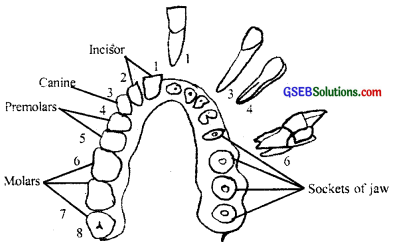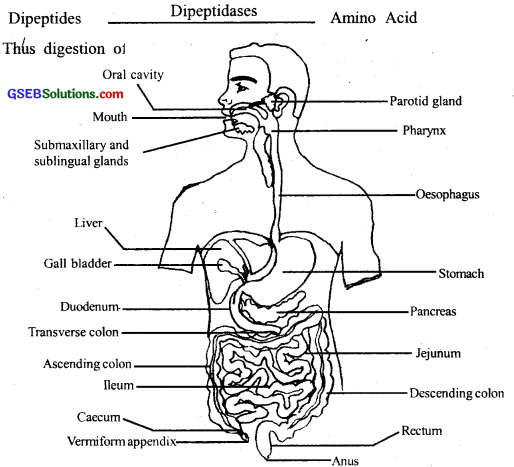Gujarat Board GSEB Textbook Solutions Class 11 Biology Chapter 16 Digestion and Absorption Textbook Questions and Answers.
Gujarat Board Textbook Solutions Class 11 Biology Chapter 16 Digestion and Absorption
GSEB Class 11 Biology Digestion and Absorption Text Book Questions and Answers
Question 1.
Choose the correct answer among the following:
(1) Gastric juice contains
- Pepsin, lipase and rennin
- Trypsin, lipase and rennin
- Trypsin, pepsin and lipase
- Trypsin, pepsin and rennin
Answer:
- Pepsin, lipase and rennin
(2) Succus entericus is the name given to
- a junction between the ileum and large intestine
- intestinal juice
- swelling in the gut
- appendix
Answer:
2. Intestinal juice
![]()
Question 2.
Match column I with Column II

Answer:
(a) 2
(b) 4
(c) 3
(d) 1
Question 3.
Answer briefly:
(a) Why are villi present in the intestine and not in the stomach?
Answer:
Villa is a structure which is meant to absorb food. Most of the digested food is absorbed in the intestine and not in the stomach. Hence villi are present in the intestine.
(b) How does pepsinogen change Into its active form?
Answer:
The pepsinogen, on exposure to hydrochloric acid secreted in the stomach, gets converted to its active enzyme form pepsin.
(c) What are the basic layers of the wall of the alimentary canal?
Answer:
Serosa, muscularis, sub-mucosa and mucosa are the four layers of alimentary canal
(d) How does bile help in the digestion of fats?
Answer:
Bile helps in breaking down fats into very small micelles which are known as emulsification. It also activates lipases that digest the fats and lipases act only on emulsified fat.
![]()
Question 4.
State the role of pancreatic juice in the digestion of proteins.
Answer:
The bile pancreatic juice and the intestinal juice are the secretions released into the small intestine. Pancreatic juice and bile are released through the hepato-pancreatic duct. The pancreatic juice contains inactive enzymes, trypsinogen, chymotrypsinogen, procarboxypeptidases, amylases, lipases and nucleases. Trypsinogen is activated by an enzyme, enterokinase, secreted by the intestinal mucosa into active trypsin’, which in turn activates the other enzymes in the pancreatic juice. Carbohydrates in the chyme are hydrolysed. ed by pancreatic amylase into disaccharides. Nucleases in the pancreatic juice act on nucleic acids to form nucleotides and nucleosides.
Question 5.
Describe the process of digestion of protein in the stomach.
Answer:
The gastro-oesophageal sphincter controls the passage of food into the stomach. The saliva secreted into the oral cavity contains electrolytes (Na+, K+, Cl–, HCO–) and enzymes, salivary amylase and lysozyme. The chemical process of digestion is initiated in the oral cavity by the hydrolytic action of the carbohydrate splitting enzyme the salivary’ amylase. About 30% of starch is hydrolysed here by this enzyme (optimum pH 6.8) into a disaccharide-maltose. Lysozyme present in saliva acts as an antibacterial agent that prevents infections.

The mucosa of the stomach has gastric glands. Gastric glands have three major types of cells namely (i) mucus neck cells which secrete mucus (ii) Peptic or chief cells which secrete the proenzyme pepsinogen and (iii) Parietal or oxyntic cells which secrete HCI and intrinsic factor (Intrinsic factor is essential for the absorption of Vitamin B12). The stomach stores the food for 4-5 hours. The food mixes thoroughly with the acidic gastric juice of the stomach by the churning movements of its muscular wall and called the chyme.
The proenzyme pepsinogen, on exposure to hydrochloric acid, gets converted into the active enzyme pepsin, the proteolytic enzyme of the stomach. Pepsin converts proteins into proteases and peptones (peptides). The mucus and bicarbonates present in tile gastric juice play an important role in lubrication and protection of ten-buccal epithelium from excoriation by the highly concentrated hydrochloric acid. HCl provides the acidic pH (pH 1.8) optimal for pepsins; Rennin is a proteolytic enzyme found in gastric juice of infants which helps in the digestion of milk proteins.
![]()
Question 6.
Give the dental formula of human beings.
Answer:
Majority of mammals including humans forms two sets of teeth during their life, a set of temporary milk or deciduous teeth replaced by a set of permanent or adult teeth. This type of dentition is called diphyodont. An adult human has 32 permanent teeth which are of four different types (Heterodont dentition), namely, incisors (I), Canine (C), Premolars (PM) and molars (M). Arrangement of teeth in each half of the upper and lower jaw in the order I, C, PM, M is represented by a dental formula which in humans is 2123/2123. The hard chewing surface of the teeth, made up of enamel, helps in the mastication of food

Question 7.
Bile juice contains no digestive enzymes, yet it is important for digestion. Why?
Answer:
Bile helps in breaking down of fats into very small micelles which is known as emulsification. It also activates lipases which act on emulsified fats and digest them. Bile also helps in stimulation, peristaltic movement, acts as a buffer and helps in lubrication of food.
![]()
Question 8.
Describe the digestive role of chymotrypsin. Which two other digestive enzymes of the same category are secreted by its source gland?
Answer:
Chymotrypsin converts proteins, peptones and proteoses into dipeptides and thus help in digestion of proteins. Other two enzymes are trypsin and carboxypeptidase.
Question 9.
How are polysaccharides and disaccharides digested?
Answer:
Intestinal juice or succus entericus contains a variety’ of enzymes like disaccharidases, dipeptidases, diglycerides, nucleosidases, etc. The mucus along with the bicarbonates from the pancreas protects the intestinal mucosa from acid as well as provide an alkaline medium (pH 7.8) for enzymatic activities. Submucosal glands (Brunner’s glands) also help in this. Carbohydrates in the chyme are hydrolysed by pancreatic amylase into disaccharides.
![]()
Digestion of starch takes place in the mouth. Carbohydrates are broken down or digested to form sugar. The saliva contains an enzyme salivary amylase that helps in the digestion of starch into sugar.
![]()
Question 10.
What would happen if HCl is not secreted in the stomach?
Answer:
HCl converts inactive pepsinogen into active pepsin. It also provides acidic medium for the action of pepsin which plays an important role in the digestion of proteins. Without HCI, gastric digestion of proteins does not take place.
Question 11.
How does butter in your food get digested and absorbed in the body?
Answer:
Butter (fat) is digested in the duodenum (small intestine) with help of the bile juice secreted by the liver. The bile juice is stored in the gall bladder. The pancreas secretes trypsin, amylase and lipase which are poured into the duodenum.
Butter (fat) absorbed in the body: Fatty acids and glycerol being insoluble, cannot be absorbed into the blood. They are first incorporated into small droplets called micelles which move into the intestinal mucosa. They are re-formed into very small protein-coated fat globules called the chylomicrons which are transported into the lymph vessels (lacteals) in the villi. These lymph vessels ultimately release the absorbed substances into the bloodstream.
Question 12.
Discuss the main steps in the digestion of proteins as the food passes through different parts of the alimentary canal.
Answer:
Digestion of protein starts in the stomach. Thus are two proteolytic enzymes-
- Pepsin – secreted by stomach and
- Trypsin -secreted by the pancreas
Digestion of Protein in the stomach: The proenzymes pepsinogen, on exposure to HCl, gets converted into active enzyme pepsin.
![]()
Pepsin always acts in acidic medium (pH 1.8) Renin only present in the stomach of ‘infants for digestion of milk- protein. Digestion of Protein in small Instestive Pancreatic juice contains proenzyme Trypsinogen. It is activated by enterokinase, secreted by the intestinal mucosa, into active trypsin. Trypsin acts in alkaline medium.
![]()
Peptones
Proteus
These dipeptides are changes into Amino-Acid by the enzyme of succus entericus.

![]()
Question 13.
Explain the terms thecodont and diphyodont.
Answer:
- Each tooth is embedded in a socket of jaw bone. This type of attachment is called thecodont.
- A set of temporary milk or deciduous teeth replaced by a set of permanent or adult teeth is called diphyodont.
Question 14.
Name different types of teeth and their number in an adult human.
Answer:
An adult human has-32 permanent teeth which are of four different types (Heterodont dentition), namely, incisors (I) 2, Canine (C) 1, Premolars (PM) 2 and molars (M) 3. Arrangement of teeth in each half of the upper and lower jaw in the order I, C, PM, M is represented by a dental formula which in human is 2123/2123. Total number of teeth = (2 + 1+2+3)X 4= 32
Question 15.
What are the functions of the liver?
Answer:
The various functions of the liver are:
(1) Digestive function: The bile juice emulsification of fats.
(2) Blood-related functions:
- The liver produces RBCs in the embryo.
- Produces prothrombin and fibrinogen which help in the clotting of blood.
- Produces heparin to prevent clotting of blood inside blood vessels.
- The dead and worn-out RBCs are broken down in the liver.
- The liver generates about 12% of the total body heat.

- Storage of blood up to 1.5 litres in the liver veins.
- Liver stores iron, copper, and vitamins A, D, and B.
- Removes toxic and metallic poisons from the blood.
(3) Metabolic functions:
- Regulation of blood sugar by changing-excess glucose into glycogen and releasing it again as glucose when blood sugar level falls.
- Breaking down of excess amino acid into urea and sugar. Urea is passed out in urine and sugar is stored for use.
- Synthesis of fatty acids from carbohydrates.